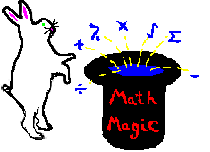

A. This type of problem is a little difficult and needs lots of practice to master.
B. To change repeating decimals of this pattern to fractions follow these steps:
1. Subtract the non-repeating digits from the non-repeating digits and the repeating digits. This is the numerator of the answer.
2. The denominator of the answer is the same number of 9's as repeating digits followed by the same number of 0's as non-repeating digits.
C. Examples:
Ex [1] .1242424... = _______ (fraction)
a. In this problem, the non-repeating digits is only the 1. So subtract 1 from 124 and get 123. This is the numerator.
b. The denominator is 990, since there are 2 digits repeating we have two 9's and only 1 non-repeating digit which means only one 0.
c. The answer is 123/990 which reduces to 41/330.
Ex [2] .11242424... = ______ (fraction)
a. In this problem, the non-repeating digits are 11. So subtract 11 from 1124 and get 1113. This is the numerator.
b. The denominator is 9900, since there are 2 digits repeating (so two 9's) and 2 digits non-repeating (so two 0's).
c. The answer is 1113/9900 which reduces to 371/3300.
Ex [3] .02121212... = _____ (fraction)
a. In this problem, the non-repeating digits are 02. So subtract 2 from 212 and get 210 (notice you can ignore the 0 in front). This is the numerator.
b. The denominator is 9900 since there are 2 digits repeating (so two 9's) and 2 digits non-repeating (so two 0's).
c. The answer is 210/9900 which reduces to 7/330.